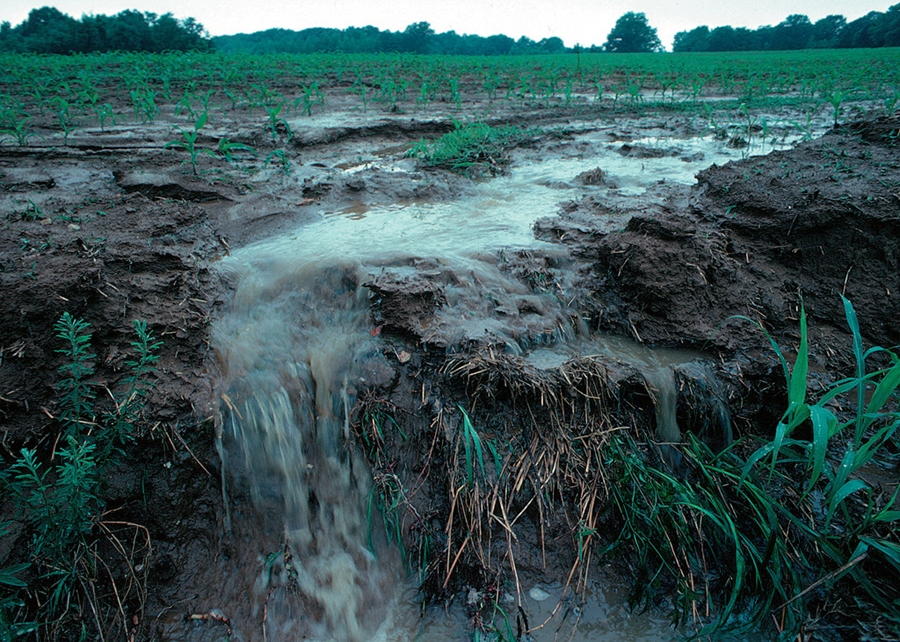NSF Funds Project to Create Commercial Fertilizer Out of Wastewater Nutrients

Runoff from crops can lead to excess nitrogen and phosphorous nutrients in wastewater systems.
FAYETTEVILLE, Ark. – A $2.4 million award from the National Science Foundation will enable a multidisciplinary team of researchers at the University of Arkansas and their colleagues at two other institutions to develop a chemical process that converts nitrogen and phosphorous from wastewater into commercial fertilizer.
The goal of the project is to make an energy-efficient fertilizer that competes with conventional, commercially available fertilizers.
“Excess nitrogen and phosphorous in wastewater, due primarily to human impact, cause serious environmental problems,” said Lauren Greenlee, assistant professor of chemical engineering and the lead principal investigator for the project. “We’re engineering a technology that takes these nutrients from the environment and recycles them, turning them into a commercial product that is energy efficient and environmentally less harmful to produce.”
The technology is based on the same general concept that has been used to develop commercialized fuel cells and electrolyzers, wherein two electrodes are separated by a membrane, which allows control of the reactions taking place and the flow of electricity in and out. The researchers will design electrodes to precipitate fertilizer “struvite,” a crystallized mineral composed of magnesium, ammonium and phosphate. The researchers will then collect the struvite in particulate form.

The electrochemical-engineering team consists of principal investigators Greenlee, Andrew Herring at the Colorado School of Mines and Julie Renner at Case Western Reserve University. They will focus on electrode design, water chemistry, electrochemical operations, struvite precipitation and the engineering of bench-scale reactor design.
The three other principal investigators are all from the University of Arkansas: Greg Thoma, professor of chemical engineering; Jennie Popp, professor of agricultural economics and agricultural business; and Kristofor Brye, professor of applied soil physics and pedology. Thoma will develop a life-cycle assessment of the proposed technology; Popp will examine the economics of implementing the technology; and Brye will study the composition, chemistry and viability of the fertilizer struvite created by the engineering team, comparing it to commercial fertilizers.
Greenlee said the project seeks to engage the local and regional community on issues related to nutrient recycling. Each year of the project, the researchers will host a workshop at the University of Arkansas and will invite regional stakeholders from across the food supply chain to discuss challenges and form partnerships between stakeholders.
“We want to develop an understanding of the needs and opportunities regarding food production, water conservation, and nutrient recycling,” Greenlee said.
The project will support the education and training of six full-time graduate students, one post-doctoral researcher and multiple undergraduate researchers.
Greenlee holds the Louis Owen Professorship in Chemical Engineering. Thoma holds the Bates Teaching Endowed Professorship in Chemical Engineering.
About the University of Arkansas: The University of Arkansas provides an internationally competitive education for undergraduate and graduate students in more than 200 academic programs. The university contributes new knowledge, economic development, basic and applied research, and creative activity while also providing service to academic and professional disciplines. The Carnegie Foundation classifies the University of Arkansas among only 2 percent of universities in America that have the highest level of research activity. U.S. News & World Report ranks the University of Arkansas among its top American public research universities. Founded in 1871, the University of Arkansas comprises 10 colleges and schools and maintains a low student-to-faculty ratio that promotes personal attention and close mentoring.
Topics
- Agriculture
- Awards
- Engineering
- Research & Innovation
- Science
- Natural Environment
- Food & Nutrition
- Dale Bumpers College of Agricultural, Food & Life Sciences
- College of Engineering
- Department of Agricultural Economics and Agribusiness
- Department of Crop, Soil and Environmental Sciences
- Ralph E. Martin Department of Chemical Engineering
Contacts
Lauren Greenlee, assistant professor of chemical engineering
College of Engineering
479-575-5976,
greenlee@uark.edu
Matt McGowan, science and research communications officer
University Relations
479-575-4246,
dmcgowa@uark.edu
Headlines
Four Students Named Goldwater Scholars; Two Earn Udall Honorable Mentions
Four U of A students have received the prestigious Goldwater Scholarship, an award for top students in mathematics, science, and engineering.
Cross-Campus Collaboration Culminates in New Outdoor Geological Installation
Grand opening event to celebrate the new GeoLab installation at the U of A’s Gearhart Hall courtyard is set for May 3. The installation will be open to the public year-round.
First Students to Use Online Degree to Hone Nursing Leadership, Elevate Patient Care
Hanna Baxendale and Wendi Kimbrell will begin coursework in the Doctor of Nursing Practice-Executive Master of Business Administration program offered by the Eleanor Mann School of Nursing and Walton College.
Join the Office for Sustainability on a Final Cruise to Campus
Cruise to Campus Wednesdays have fostered a gathering space for individuals interested in biking to campus. Drop by the Old Main Lawn from 7:30-10 a.m. Wednesday for coffee, something to eat and conversation.
Fay Jones School Student Ambassador Program Gives Voice to Design Students
The student ambassador program at the Fay Jones School of Architecture and Design is built to connect top design students with their school, its alumni, its future students and others inside and outside the school.




